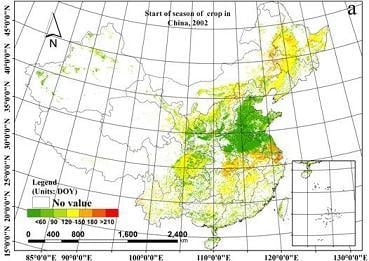Remote Sensing Based Detection of Crop Phenology for Agricultural Zones in China Using a New Threshold Method
Abstract
:1. Introduction
2. Materials and Methods
2.1. Materials
2.2. Methods
2.2.1. Data Preprocessing
2.2.2. Determining Thresholds for Phenology Detection
2.2.3. Comparison and Verification
3. Results and Discussion
3.1. Phenology Detection Thresholds for the Agricultural Zones
3.2. Accuracy Evaluation of Detection Results
3.3. Maps of the Phenological Events
3.4. Discussion of the Methodology
4. Conclusions
Acknowledgments
Conflict of Interest
References
- Sakamoto, T.; Yokozawa, M.; Toritani, H.; Shibayama, M.; Ishitsuka, N.; Ohno, H. A crop phenology detection method using time-series modis data. Remote Sens. Environ 2005, 96, 366–374. [Google Scholar]
- Thenkabail, P.S. Global croplands and their importance for water and food security in the twenty-first century: Towards an ever green revolution that combines a second green revolution with a blue revolution. Remote Sens 2010, 2, 2305–2312. [Google Scholar]
- Becker-Reshef, I.; Justice, C.; Sullivan, M.; Vermote, E.; Tucker, C.; Anyamba, A.; Small, J.; Pak, E.; Masuoka, E.; Schmaltz, J.; et al. Monitoring global croplands with coarse resolution earth observations: The global agriculture monitoring (glam) project. Remote Sens 2010, 2, 1589–1609. [Google Scholar]
- Cong, N.; Piao, S.; Chen, A.; Wang, X.; Lin, X.; Chen, S.; Han, S.; Zhou, G.; Zhang, X. Spring vegetation green-up date in china inferred from spot NDVI data: A multiple model analysis. Agric. For. Meteorol 2012, 165, 104–113. [Google Scholar]
- Savitzky, A.; Golay, M. Smoothing and differentiation of data by simplified least squares procedures. Anal. Chem 1964, 36, 1627–1639. [Google Scholar]
- Chen, J.; Jönsson, P.; Tamura, M.; Gu, Z.; Matsushita, B.; Eklundh, L. A simple method for reconstructing a high-quality NDVI time-series data set based on the Savitzky–Golay filter. Remote Sens. Environ 2004, 91, 332–344. [Google Scholar]
- Hird, J.N.; McDermid, G.J. Noise reduction of NDVI time series: An empirical comparison of selected techniques. Remote Sens. Environ 2009, 113, 248–258. [Google Scholar]
- White, M.A.; De Beurs, K.M.; Didan, K.; Inouye, D.W.; Richardson, A.D.; Jensen, O.P.; O’Keefe, J.; Zhang, G.; Nemani, R.R.; van Leeuwen, W.J.D.; et al. Intercomparison, interpretation, and assessment of spring phenology in North America estimated from remote sensing for 1982–2006. Glob. Change Biol 2009, 15, 2335–2359. [Google Scholar]
- Beck, P.S.A.; Atzberger, C.; Høgda, K.A.; Johansen, B.; Skidmore, A.K. Improved monitoring of vegetation dynamics at very high latitudes: A new method using modis NDVI. Remote Sens. Environ 2006, 100, 321–334. [Google Scholar]
- Atkinson, P.M.; Jeganathan, C.; Dash, J.; Atzberger, C. Inter-comparison of four models for smoothing satellite sensor time-series data to estimate vegetation phenology. Remote Sens. Environ 2012, 123, 400–417. [Google Scholar]
- Jönsson, P.; Eklundh, L. Seasonality extraction by function fitting to time-series of satellite sensor data. IEEE Trans. Geosci. Remot. Sens 2002, 40, 1824–1832. [Google Scholar]
- Roerink, G.J.; Menenti, M.; Soepboer, W.; Su, Z. Assessment of climate impact on vegetation dynamics by using remote sensing. Phys. Chem. Earth 2003, 28, 103–109. [Google Scholar]
- Zhang, X.; Friedl, M.A.; Schaaf, C.B.; Strahler, A.H.; Hodges, J.C.F.; Gao, F.; Reed, B.C.; Huete, A. Monitoring vegetation phenology using MODIS. Remote Sens. Environ 2003, 84, 471–475. [Google Scholar]
- Eilers, P.H.C. A perfect smoother. Anal. Chem 2003, 75, 3631–3636. [Google Scholar]
- Atzberger, C.; Eilers, P.H.C. A time series for monitoring vegetation activity and phenology at 10-daily time steps covering large parts of South America. Int. J. Digit. earth 2011, 4, 365–386. [Google Scholar]
- Atzberger, C.; Eilers, P.H.C. Evaluating the effectiveness of smoothing algorithms in the absence of ground reference measurements. Int. J. Remote Sens 2011, 32, 3689–3709. [Google Scholar]
- Hermance, J.F.; Jacob, R.W.; Bradley, B.A.; Mustard, J.F. Extracting phenological signals from multiyear AVHRR NDVI time series: Framework for applying high-order annual splines with roughness damping. IEEE Trans. Geosci. Remote Sens 2007, 45, 3264–3276. [Google Scholar]
- Zhu, W.; Pan, Y.; He, H.; Wang, L.; Mou, M.; Liu, J. A changing-weight filter method for reconstructing a high-quality NDVI time series to preserve the integrity of vegetation phenology. IEEE Trans. Geosci. Remote Sens 2012, 50, 1085–1094. [Google Scholar]
- Jeong, S.J.; Ho, C.H.; Gim, H.J.; Brown, M.E. Phenology shifts at start vs. end of growing season in temperate vegetation over the Northern Hemisphere for the period 1982–2008. Glob. Change Biol 2011, 17, 2385–2399. [Google Scholar]
- Lloyd, D. Phenological classification of terrestrial vegetation cover using shortwave vegetation index imagery. Int. J. Remote Sens 1990, 11, 2269–2279. [Google Scholar]
- Delbart, N.; Le Toan, T.; Kergoat, L.; Fedotova, V. Remote sensing of spring phenology in boreal regions: A free of snow-effect method using NOAA-AVHRR and SPOT-VGT data (1982–2004). Remote Sens. Environ 2006, 101, 52–62. [Google Scholar]
- White, M.A.; Nemani, R.R. Real-time monitoring and short-term forecasting of land surface phenology. Remote Sens. Environ 2006, 104, 43–49. [Google Scholar]
- Wu, W.; Yang, P.; Tang, H.; Zhou, Q.; Chen, Z.; Shibasaki, R. Characterizing spatial patterns of phenology in cropland of China based on remotely sensed data. J. Integr. Agric 2010, 9, 101–112. [Google Scholar]
- Moody, A.; Johnson, D.M. Land-surface phenologies from AVHRR using the discrete fourier transform. Remote Sens. Environ 2001, 75, 305–323. [Google Scholar]
- Reed, B.C.; Brown, J.F.; VanderZee, D.; Loveland, T.R.; Merchant, J.W.; Ohlen, D.O. Measuring phenological variability from satellite imagery. J. Veg. Sci 1994, 5, 703–714. [Google Scholar]
- Duchemin, B.T.; Goubier, J.; Courrier, G. Monitoring phenological key stages and cycle duration of temperate deciduous forest ecosystems with NOAA/AVHRR data. Remote Sens. Environ 1999, 67, 68–82. [Google Scholar]
- Yu, F.; Kevin, P.P.; James, E.; Shi, P. Response of seasonal vegetation development to climatic variations in Eastern Central Asia. Remote Sens. Environ 2003, 87, 42–54. [Google Scholar]
- Dash, J.; Jeganathan, C.; Atkinson, P.M. The use of MERIS terrestrial chlorophyll index to study spatio-temporal variation in vegetation phenology over India. Remote Sens. Environ. 2010, 1388–1402. [Google Scholar]
- Pan, Y.; Li, L.; Zhang, J.; Liang, S.; Zhu, X.; Sulla-Menashe, D. Winter wheat area estimation from MODIS-EVI time series data using the crop proportion phenology index. Remote Sens. Environ 2012, 119, 232–242. [Google Scholar]
- Kaufmann, R.K.; Zhou, L.; Knyazikhin, Y.; Shabanov, N.V.; Tucker, C.J. Effect of orbital drift and sensor changes on the time series of AVHRR vegetation index data. IEEE Trans. Geosci. Remote Sens 2000, 38, 2584–2597. [Google Scholar]
- Liu, J.; Liu, M.; Tian, H.; Zhuang, D.; Zhang, Z.; Zhang, W.; Tang, X.; Deng, X. Spatial and temporal patterns of china’s cropland during 1990–2000: An analysis based on Landsat TM data. Remote Sens. Environ 2005, 98, 442–456. [Google Scholar]
- Meng, J.; Wu, B.; Li, Q. Method for estimating crop leaf area index of China using remote sensing (in Chinese). Trans. CSAE 2007, 23, 160–167. [Google Scholar]
- Delbart, N.; Kergoat, L.; Le Toan, T.; Lhermitte, J.; Picard, G. Determination of phenological dates in boreal regions using normalized difference water index. Remote Sens. Environ 2005, 97, 26–38. [Google Scholar]
- Zhang, F.; Wu, B.; Liu, C.; Luo, Z. Methods of monitoring crop phenological stages using time series of vegetation indicator (in Chinese). Trans. CSAE 2004, 20, 138–143. [Google Scholar]
- Schwarts, M.D.; Reed, B.C. Surface phenology and satellite sensor-derived onset of greenness: An initial comparison. Int. J. Remote Sens 1999, 20, 3451–3457. [Google Scholar]
- Willmott, C.J. Some comments on the evaluation of model performance. Bull. Amer. Meteorol. Soc 1982, 63, 1390–1313. [Google Scholar]
- Kang, J.X. Omega-3: A link between global climate change and human health. Biotechnol. Adv 2011, 29, 388–390. [Google Scholar]
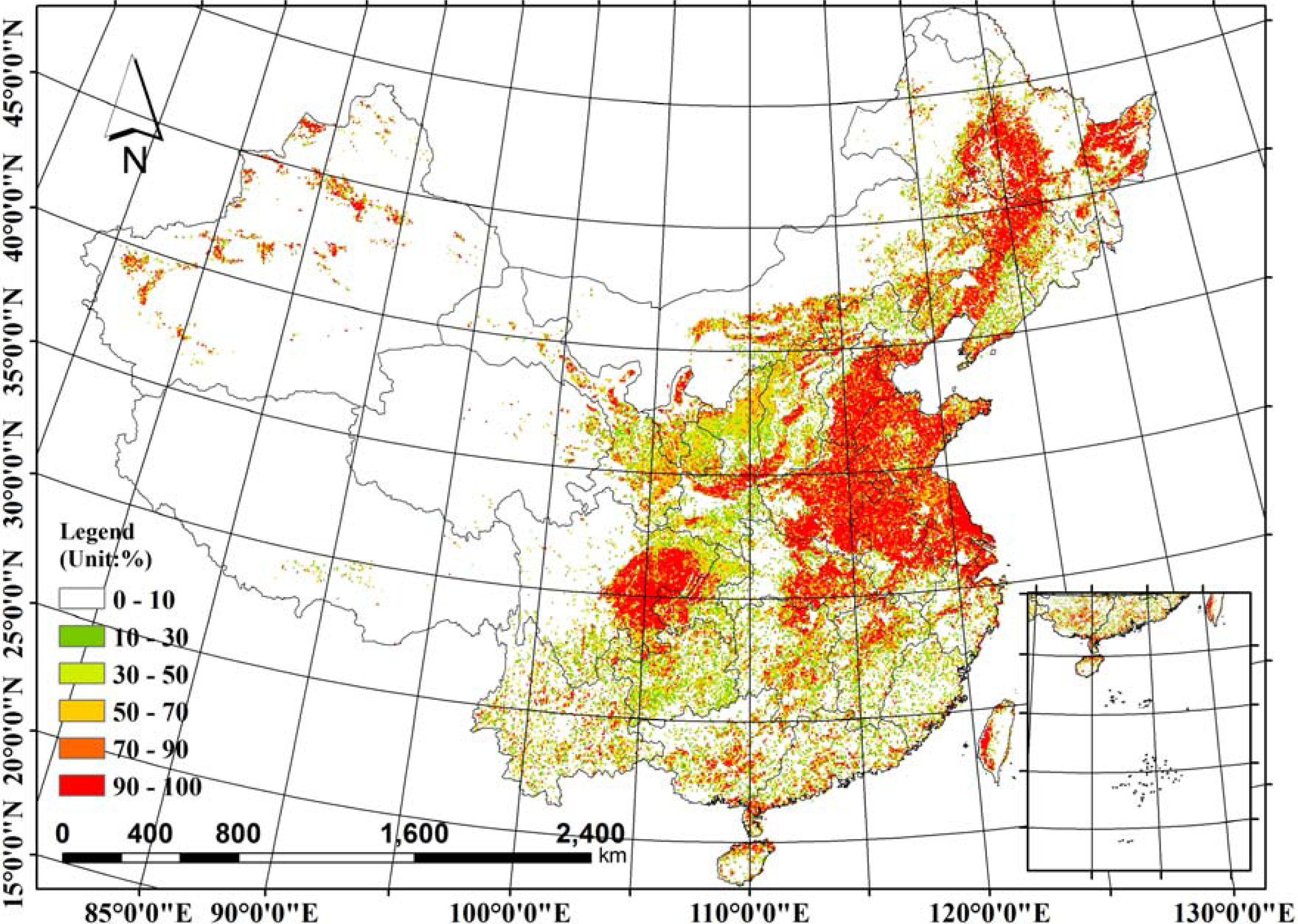
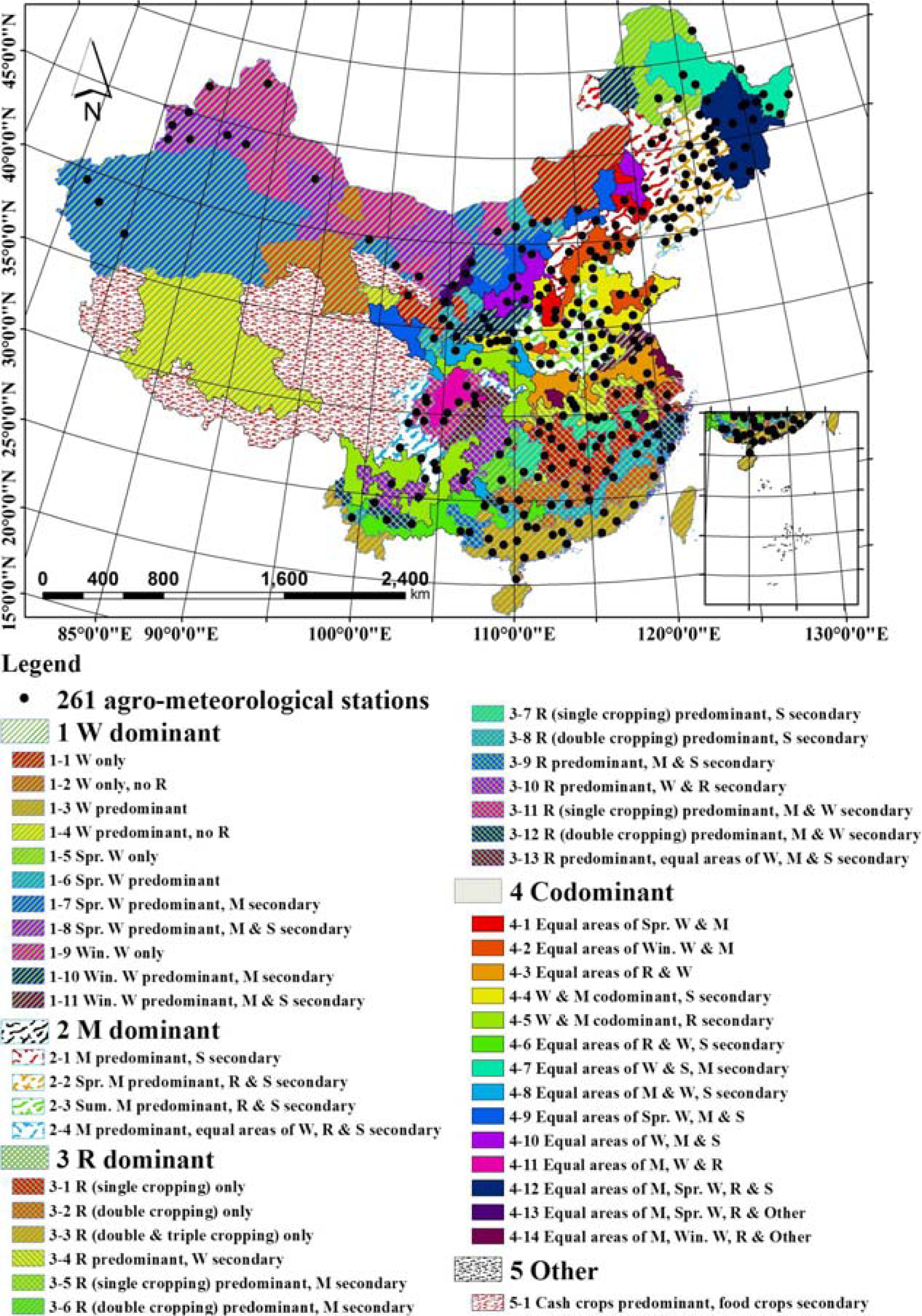
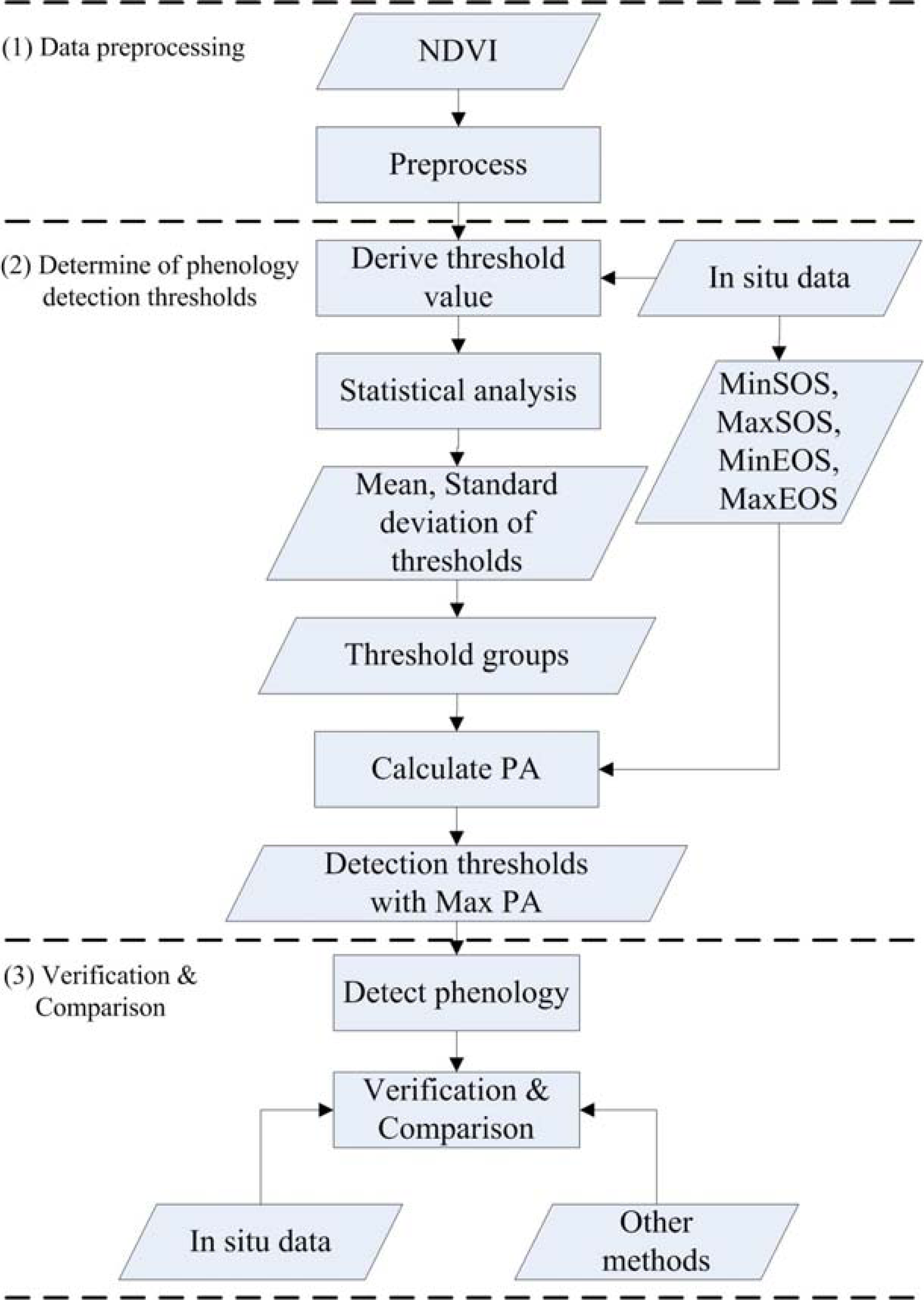
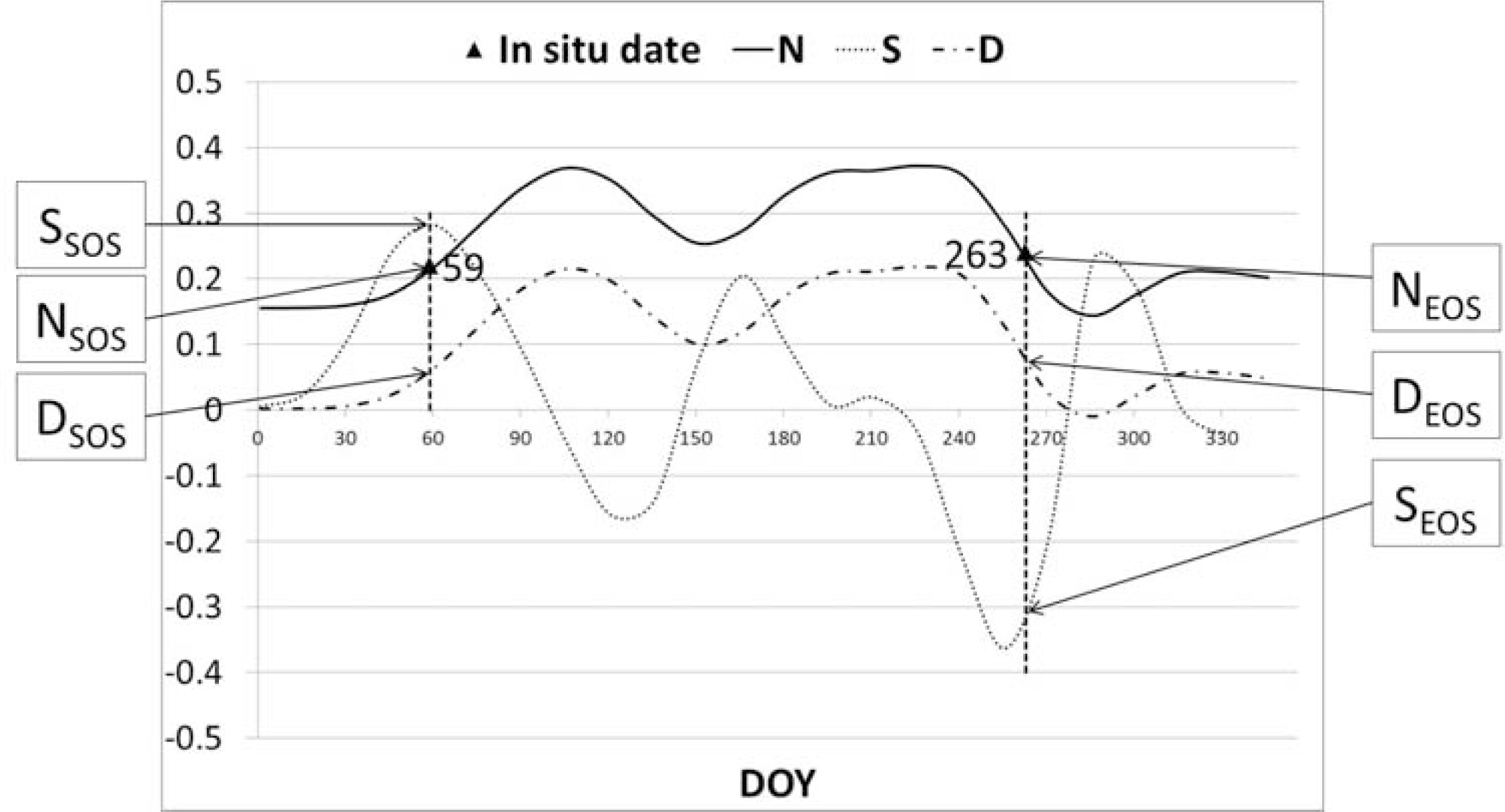
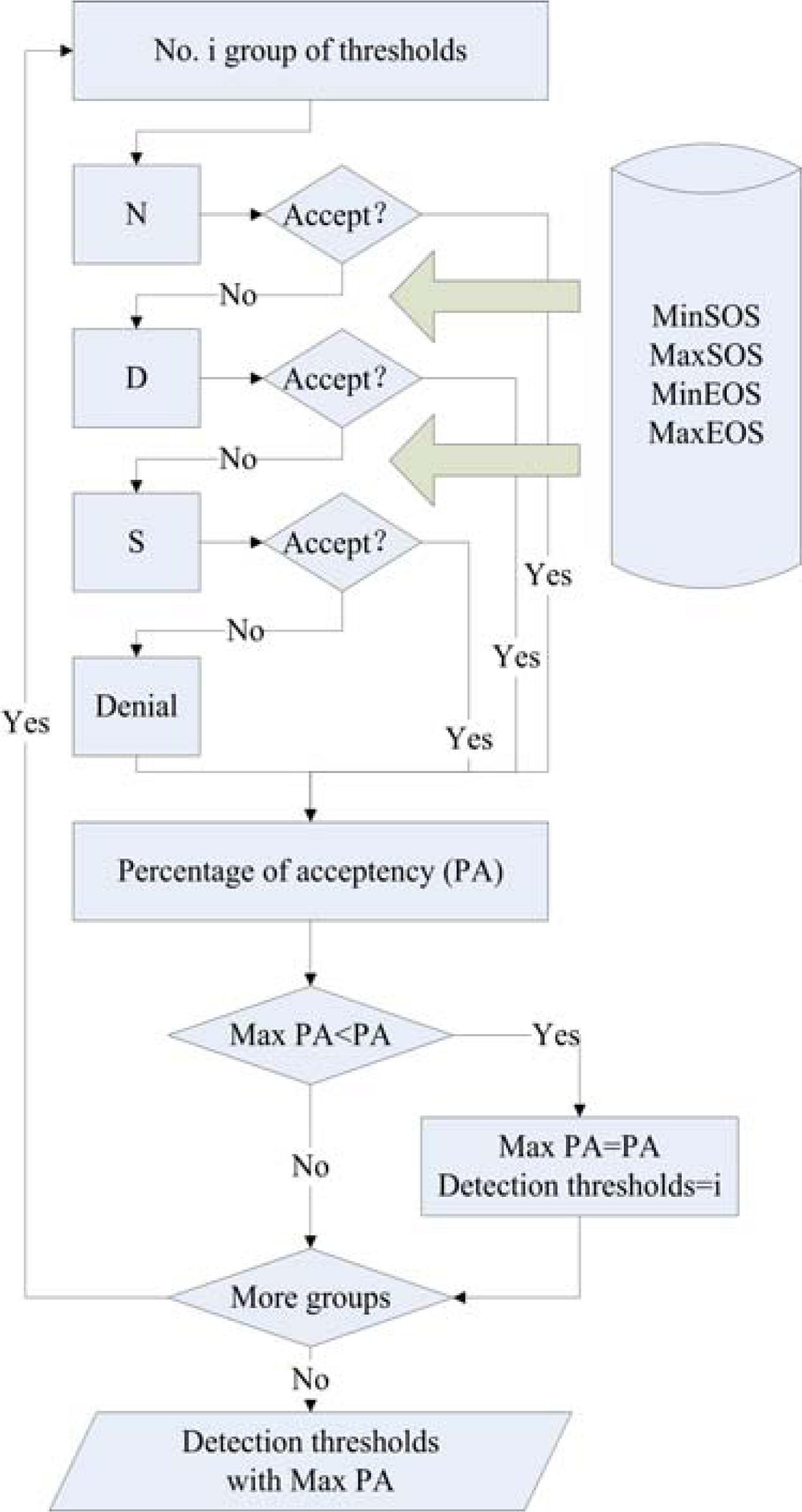
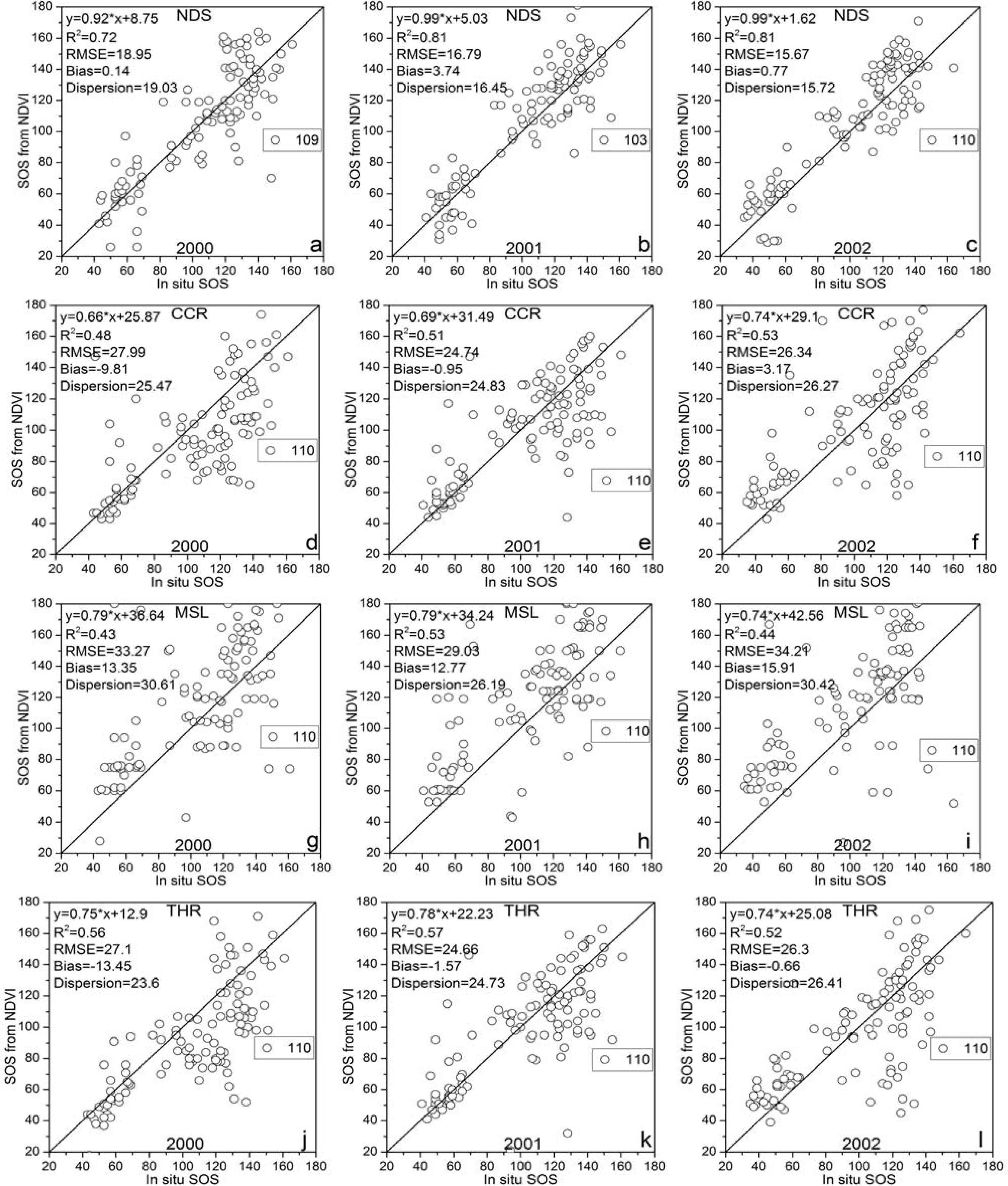
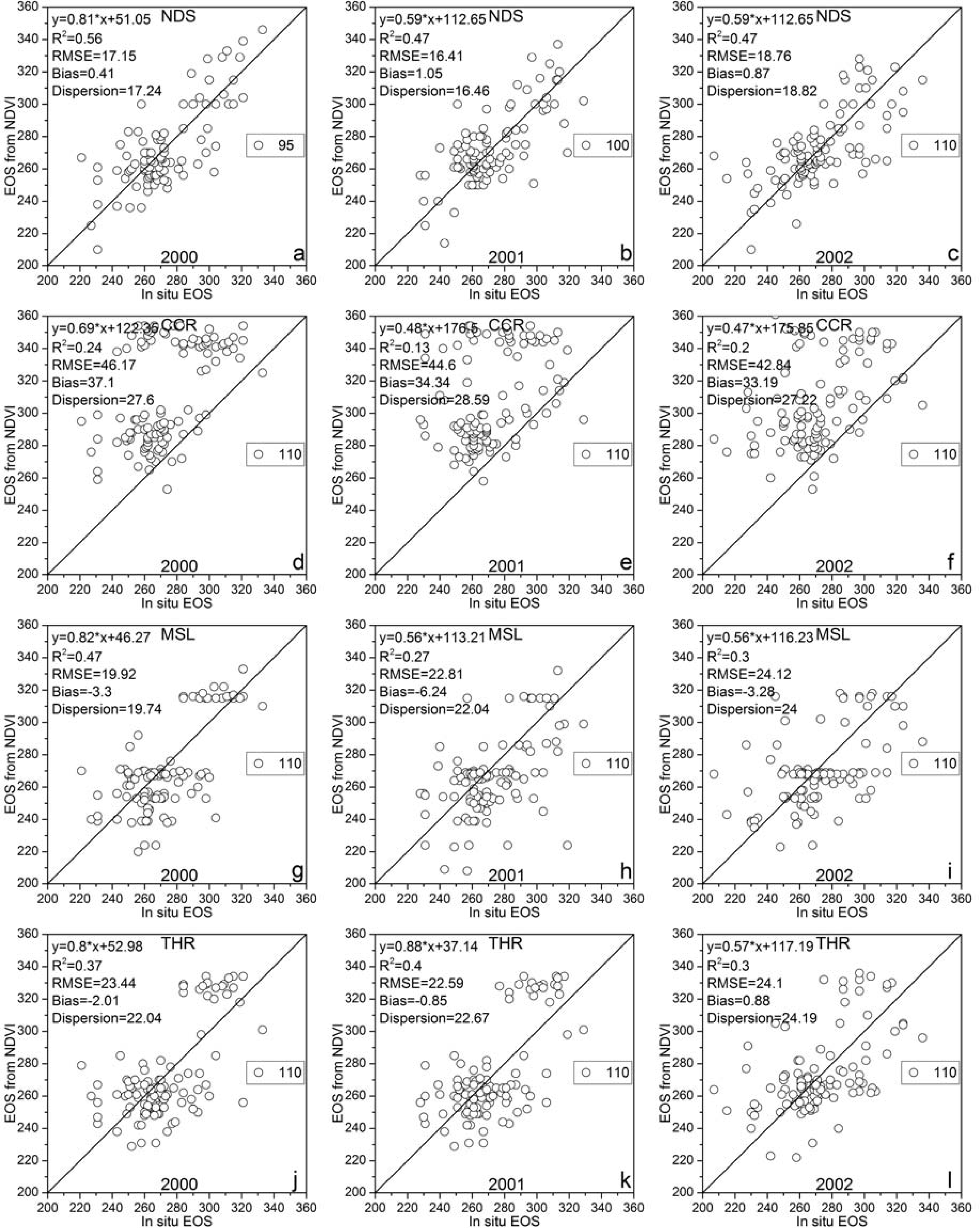
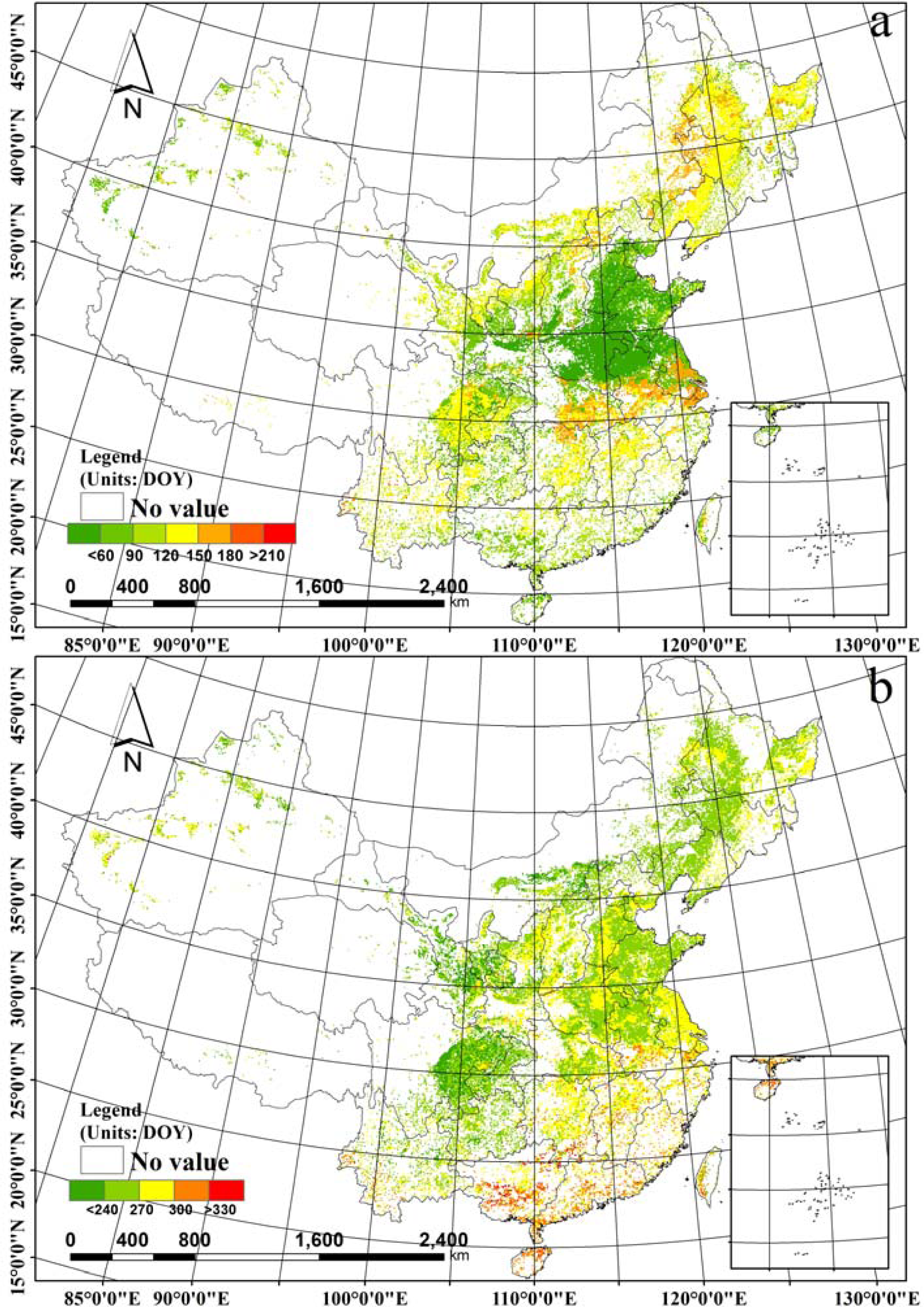
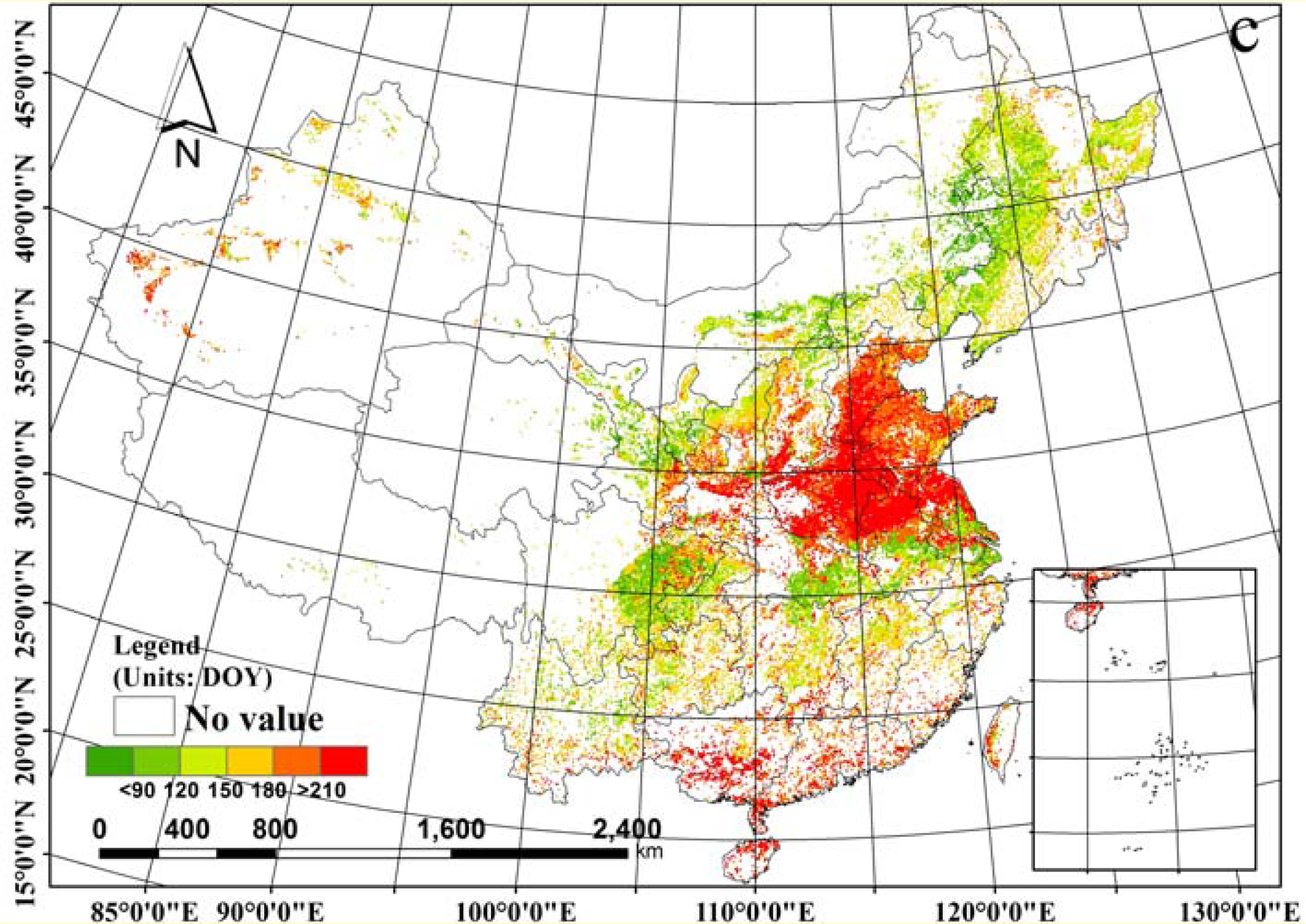

| Zone | N | D | S | Min SOS | Max SOS | PA | Zone | N | D | S | Min SOS | Max SOS | PA |
|---|---|---|---|---|---|---|---|---|---|---|---|---|---|
| 1-1 | 0.183 | 0.183 | 0.02 | 114 | 136 | 95% | 3-8 | 0.43 | 0.124 | 0.006 | 96 | 126 | 93% |
| 1-2 | 0.183 | 0.031 | 0.02 | 114 | 136 | 91% | 3-9 | 0.222 | 0.081 | 0.007 | 85 | 110 | 93% |
| 1-3 | 0.284 | 0.016 | 0.005 | 85 | 110 | 88% | 3-10 | 0.343 | 0.009 | 0.003 | 92 | 122 | 25% |
| 1-4 | 0.198 | 0.031 | 0.02 | 114 | 136 | 89% | 3-11 | 0.413 | 0.152 | 0.003 | 117 | 139 | 66% |
| 1-5 | 0.47 | 0.191 | 0.007 | 138 | 163 | 87% | 3-12 | 0.469 | 0.067 | 0.004 | 88 | 118 | 72% |
| 1-6 | 0.144 | 0.102 | 0.007 | 103 | 133 | 95% | 3-13 | 0.512 | 0.288 | 0.008 | 117 | 139 | 73% |
| 1-7 | 0.158 | 0.005 | 0.005 | 58 | 88 | 50% | 4-1 | 0.108 | 0.053 | 0.003 | 93 | 123 | 76% |
| 1-8 | 0.117 | 0.122 | 0.011 | 84 | 114 | 84% | 4-2 | 0.238 | 0.003 | 0.008 | 37 | 55 | 96% |
| 1-9 | 0.12 | 0.138 | 0.007 | 93 | 123 | 80% | 4-3 | 0.46 | 0.059 | 0.015 | 94 | 124 | 28% |
| 1-10 | 0.233 | 0.024 | 0.007 | 49 | 67 | 91% | 4-4 | 0.316 | 0.008 | 0.01 | 37 | 67 | 92% |
| 1-11 | 0.36 | 0.013 | 0.009 | 37 | 55 | 98% | 4-5 | 0.432 | 0.098 | 0.007 | 72 | 102 | 57% |
| 2-1 | 0.135 | 0.232 | 0.01 | 121 | 151 | 80% | 4-6 | 0.416 | 0.034 | 0.002 | 77 | 107 | 80% |
| 2-2 | 0.48 | 0.171 | 0.022 | 124 | 151 | 85% | 4-7 | 0.222 | 0.259 | 0.003 | 120 | 148 | 92% |
| 2-3 | 0.367 | 0.013 | 0.011 | 45 | 61 | 89% | 4-8 | 0.248 | 0.061 | 0.001 | 72 | 102 | 25% |
| 2-4 | 0.383 | 0.009 | 0.004 | 45 | 61 | 38% | 4-9 | 0.144 | 0.117 | 0.007 | 103 | 133 | 94% |
| 3-1 | 0.461 | 0.134 | 0.015 | 109 | 139 | 65% | 4-10 | 0.162 | 0.056 | 0.004 | 100 | 130 | 89% |
| 3-2 | 0.416 | 0.097 | 0.005 | 90 | 120 | 91% | 4-11 | 0.512 | 0.278 | 0.009 | 123 | 137 | 85% |
| 3-3 | 0.429 | 0.048 | 0.003 | 85 | 110 | 86% | 4-12 | 0.273 | 0.272 | 0.01 | 126 | 156 | 69% |
| 3-4 | 0.54 | 0.167 | 0.009 | 123 | 153 | 42% | 4-13 | 0.159 | 0.01 | 0.004 | 86 | 116 | 82% |
| 3-5 | 0.113 | 0.001 | 0.008 | 54 | 84 | 97% | 4-14 | 0.488 | 0.116 | 0.003 | 94 | 124 | 27% |
| 3-6 | 0.297 | 0.22 | 0.001 | 119 | 149 | 97% | 5-1 | 0.3 | 0.031 | 0.024 | 114 | 136 | 58% |
| 3-7 | 0.484 | 0.172 | 0.007 | 111 | 146 | 86% | Total | 77% |
| Zone | N | D | S | Min EOS | Max EOS | PA | Zone | N | D | S | Min EOS | Max EOS | PA |
|---|---|---|---|---|---|---|---|---|---|---|---|---|---|
| 1-1 | 0.464 | 0.18 | −0.02 | 234 | 253 | 92% | 3-8 | 0.592 | 0.208 | −0.005 | 293 | 303 | 66% |
| 1-2 | 0.464 | 0.113 | −0.02 | 234 | 253 | 45% | 3-9 | 0.377 | 0.183 | −0.001 | 295 | 325 | 86% |
| 1-3 | 0.222 | 0.126 | −0.006 | 295 | 325 | 68% | 3-10 | 0.535 | 0.252 | −0.004 | 237 | 267 | 64% |
| 1-4 | 0.464 | 0.113 | −0.02 | 234 | 253 | 58% | 3-11 | 0.488 | 0.213 | −0.004 | 222 | 252 | 88% |
| 1-5 | 0.297 | 0.156 | −0.026 | 271 | 281 | 97% | 3-12 | 0.507 | 0.136 | −0.016 | 277 | 307 | 88% |
| 1-6 | 0.411 | 0.168 | −0.003 | 218 | 240 | 93% | 3-13 | 0.55 | 0.332 | −0.006 | 222 | 252 | 78% |
| 1-7 | 0.326 | 0.143 | −0.002 | 264 | 280 | 75% | 4-1 | 0.501 | 0.16 | −0.015 | 240 | 269 | 95% |
| 1-8 | 0.486 | 0.262 | −0.004 | 251 | 281 | 77% | 4-2 | 0.441 | 0.137 | −0.016 | 263 | 281 | 98% |
| 1-9 | 0.352 | 0.155 | −0.037 | 247 | 267 | 76% | 4-3 | 0.373 | 0.182 | −0.008 | 272 | 296 | 86% |
| 1-10 | 0.533 | 0.198 | −0.006 | 252 | 267 | 73% | 4-4 | 0.419 | 0.179 | −0.023 | 255 | 285 | 97% |
| 1-11 | 0.414 | 0.175 | −0.005 | 263 | 281 | 93% | 4-5 | 0.426 | 0.191 | −0.013 | 251 | 281 | 66% |
| 2-1 | 0.462 | 0.192 | −0.006 | 251 | 271 | 97% | 4-6 | 0.571 | 0.197 | −0.004 | 267 | 297 | 76% |
| 2-2 | 0.456 | 0.221 | −0.021 | 259 | 281 | 99% | 4-7 | 0.356 | 0.245 | −0.03 | 265 | 273 | 100% |
| 2-3 | 0.343 | 0.185 | −0.02 | 255 | 285 | 95% | 4-8 | 0.483 | 0.219 | −0.004 | 251 | 281 | 77% |
| 2-4 | 0.483 | 0.236 | −0.011 | 255 | 285 | 74% | 4-9 | 0.411 | 0.141 | −0.013 | 251 | 271 | 94% |
| 3-1 | 0.386 | 0.201 | −0.003 | 277 | 306 | 93% | 4-10 | 0.305 | 0.152 | −0.006 | 259 | 289 | 99% |
| 3-2 | 0.365 | 0.188 | −0.002 | 280 | 310 | 82% | 4-11 | 0.446 | 0.351 | −0.006 | 232 | 240 | 83% |
| 3-3 | 0.415 | 0.14 | −0.002 | 295 | 325 | 68% | 4-12 | 0.355 | 0.195 | −0.027 | 255 | 281 | 100% |
| 3-4 | 0.447 | 0.146 | −0.007 | 263 | 293 | 88% | 4-13 | 0.223 | 0.048 | −0.018 | 261 | 279 | 91% |
| 3-5 | 0.354 | 0.137 | −0.016 | 261 | 291 | 100% | 4-14 | 0.415 | 0.115 | −0.012 | 272 | 296 | 87% |
| 3-6 | 0.426 | 0.191 | −0.004 | 252 | 279 | 48% | 5-1 | 0.464 | 0.18 | −0.02 | 234 | 253 | 63% |
| 3-7 | 0.471 | 0.136 | −0.006 | 283 | 299 | 79% | Total | 88% |
| 2000 | 2001 | 2002 | Average | |||
|---|---|---|---|---|---|---|
| SOS | RMSE | NDS | 18.95 | 16.79 | 15.67 | 17.14 |
| CCR | 27.99 | 24.74 | 26.34 | 26.36 | ||
| MSL | 33.27 | 29.03 | 34.21 | 32.17 | ||
| THR | 27.1 | 24.66 | 26.3 | 26.02 | ||
| RIA | RIANDS,CCR | 32.30% | 32.13% | 40.51% | 34.98% | |
| RIANDS,MSL | 43.04% | 42.16% | 54.19% | 46.47% | ||
| RIANDS,THR | 30.07% | 31.91% | 40.42% | 34.14% | ||
| EOS | RMSE | NDS | 17.15 | 16.41 | 18.76 | 17.44 |
| CCR | 46.17 | 44.6 | 42.84 | 44.54 | ||
| MSL | 19.92 | 22.81 | 24.12 | 22.28 | ||
| THR | 23.44 | 22.59 | 24.1 | 23.38 | ||
| RIA | RIANDS,CCR | 62.85% | 63.21% | 56.21% | 60.76% | |
| RIANDS,MSL | 13.91% | 28.06% | 22.22% | 21.40% | ||
| RIANDS,THR | 26.83% | 27.36% | 22.16% | 25.45% |
© 2013 by the authors; licensee MDPI, Basel, Switzerland This article is an open access article distributed under the terms and conditions of the Creative Commons Attribution license (http://creativecommons.org/licenses/by/3.0/).
Share and Cite
You, X.; Meng, J.; Zhang, M.; Dong, T. Remote Sensing Based Detection of Crop Phenology for Agricultural Zones in China Using a New Threshold Method. Remote Sens. 2013, 5, 3190-3211. https://doi.org/10.3390/rs5073190
You X, Meng J, Zhang M, Dong T. Remote Sensing Based Detection of Crop Phenology for Agricultural Zones in China Using a New Threshold Method. Remote Sensing. 2013; 5(7):3190-3211. https://doi.org/10.3390/rs5073190
Chicago/Turabian StyleYou, Xingzhi, Jihua Meng, Miao Zhang, and Taifeng Dong. 2013. "Remote Sensing Based Detection of Crop Phenology for Agricultural Zones in China Using a New Threshold Method" Remote Sensing 5, no. 7: 3190-3211. https://doi.org/10.3390/rs5073190



